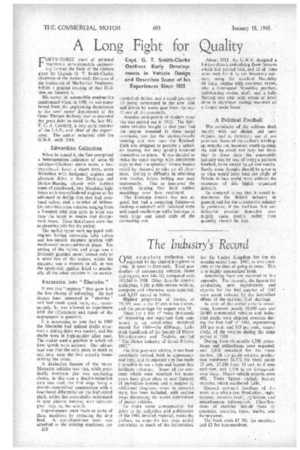A Long Fight for Quality
Page 30

If you've noticed an error in this article please click here to report it so we can fix it.
Capt. G. T. Smith-Clarke Outlines Early Developments in Vehicle Design and Describes Some of his Experiences Since 1905
FORTY-THREE years of personal experiewe in•autornobile engineering formed the basis of the address given by Captain G. T. Smith Clarke, chairman of the Automobile Division of . the Institution of Mechanical Engineers, before a general meeting of that Division.on January 6, His career in automobile engineering commenced when, in 1905, he was transferred from the engineering department to the road motor department of the Great Western Railway, and he recorded the great debt he Owed to the late Mr. F. C. A. Coventry, a very early member of the I.A.E., and chief of the department. The author remained with the G.W.R. until 1914.
, Edwardian Collection
When he joined it, the fleet comprised a heterogeneous collection of some 60 vehicles—Glarksw steam buses, a battery-electric lorry; a steam lorry, some Wolseleys with horizontal engines and all-chain driv:.. a few Durkopp and Straker-Bussing chassis with various types of coachwork, two Maudslay light buses with two-cylindered engines so far advanced in design that they had overhead valves, and a number of MilnesDaimler-Mercedes vehicles ranging from 5-tonner with iron tyres to what was then the latest in singleand doubledeck buses. These last chassis were fine engineering jobs for the period.
The earlier types were equipped with engines having automatic inlet valves and low-tensbn magneto ignition with mechanical make-and-break plugs, The setting of the valves and plugs was a jealously guarded secret, known only to a select few of the seniors, whilst the magneto was a mystery to all, as was the spark-coil ignition fitted to practically all the other vehicles in the service.
Excursion into " Electrics "
It was this "mystery" that gave him the first chance of advancing. He had always been interested in " electrics " and had made spark coils, etc., consequently, he was allowed to experiment with the adjustment and repair of the -instruments in question.
It is interesting to note that in 1905 the Mercedes had splined shafts wherever a sliding drive was needed, and the shafts were in high-quality alloy steel. The maker used a gearbox in which all four speeds were indirect. One advantage was that the only gears in mesh at one time were the two actually transmitting the drive.
A distinctive feature of the heavy Mercedes vehicles was that, while practically everyone else was employing chains, in this case a double-reduction axle was used, the first stage being a double-crown wheelconstruction with a four-bevel differential on the high-speed shaft, whilst the cross-shafts terminated in spur pinions meshink-.; with internalgear rings on the wheels.
Improvements were made to some of these machines by replacing the drip feed. A cast-aluminium tank was attached to the existing crankcase, the a28 crankshaft drilied, and a small gear-type oil pump submerged in the new tank and driven by worm gear from the rear of one of the camshafts.
Another anticipation of modern practice was carried out in 1910: The Mercedes vehicles bought in that year had the engine mounted in three metal trunnions, one for the starting-handle housing and two near the flywheel. Each was designed to provide a spherical bearing, but they quickly knocked themselves to pieces. It was decided to make the outer casings with detachable caps so that the spherical bronze bushes could be clamped to take up all clearance. Owing to difficulty in obtaining new bushes, balata belting was used temporarily. This so improved the smooth running that hard rubber mouldings were then employed.
The Durkopp chassis was not so good, but had a surprising feature—a built-up crankshaft with balanced webs and caged needle-type roller bearings in both large and small ends of the connecting rod. About 1913, the G.W.R. designed a 3-4-ton chassis embodying those features which had proved best, and 12 of these were built for it by the Maudslay concern, using the standard Maudslay 40 b.h.p. engine with overhead valves, also a four-speed Maudslay gearbox, ball-bearing cardan shaft, and a fully floating rear axle with worm or bevel drive in aluminum casings mounted on a forged main beam.
A Political Football
The remainder of the address dealt mainly with car design and aero engines, and is, therefore, out of our province. Some of the author's windingup remarks are, however, worth quoting. He said he could not help but think that in these days the automobile industry was by way of being a political football, to be kicked by all and sundry. Surely some thought should be given as to what would have been the plight of Britain in two world wars without the resources of this highly organized industry.
He ventured to say that it would be disastrous for British industry in general, and for the automobile industry in particular, if the tradition that our industrial prestige depended very largely upon. quality rather than quantity should be lost.












































































